Staurogyne repens carpet is among the most popular freshwater plants belonging to the Acanthaceae family, with over 2500 species worldwide. The Cristalino River, located in South America, is home to this species. It’s a tough plant that can withstand many of the mistakes that new fishkeepers make. As a result, it’s appropriate for anyone wishing to incorporate some vegetation into their aquarium.
Staurogyne repens, like all plants, will improve the quality of the aquarium’s water, assisting you in keeping your tank clean. As it photosynthesizes, it will release oxygen and eliminate some of the nitrate and toxins present in the water. The brilliant green colors and bushy appearance distinguish this plant from others; it’s a popular option in aqua-scaped tanks.
Table of Contents
Staurogyne Repens Carpet Overview
Staurogyne repens is a multipurpose aquarium plant belonging to the Acanthaceae family of the dicotyledonous floating plants, with approximately 2500 species and 250 genera. The Staurogyne genus has six freshwater species, the most common of which is Staurogyne repens, which is well-known for its usage in freshwater aquarium decoration. In the South Amazonas, the River Rio Cristalino situated in Mato Grosso is the source of this freshwater plant species. On the banks of the fast-flowing river, the little plant grows on and between hardscapes (rocks).
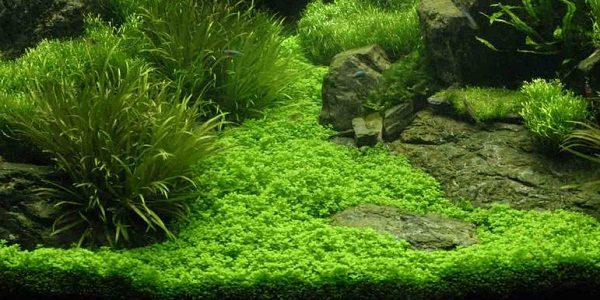
Staurogyne repens has a food value, which is interesting information. This plant grows wild, and native people use its leaves to cook rice with a pleasant flavor.
Information Chart
| Information Chart | Staurogyne Repens |
|---|---|
| Scientific Name: | Staurogyne repens |
| Family: | Acanthaceae |
| Care Level: | Easy |
| Growth Rate: | Slow |
| Maximum Size: | 4 inches |
| Minimum Tank Size: | 10 gallons |
| Water Conditions: | 68-86°F, pH 5-8, KH 3-10 |
| Lighting: | Moderate to high |
| Propagation: | Side shoots/cutting |
| Placement: | Forms a carpet |
Staurogyne Repens Carpet Appearance
Staurogyne repens resembles species of the invasive Hygrophila genus, which includes South American marsh weeds, but it is taller and has larger leaves. It has a vivid green color, brighter than other hardy forms such as hornwort.
The stems are rigid to keep them in place in the tank. Their leaves are lively and densely packed, making them perfect for creating a carpet on top of the substrate.
This carpet will grow about 2-4 inches tall, giving you lots of open swimming space beyond a mature plant.
The leaves themselves have a pretty classic leaf shape, being an oval with a broad base and a tip at the end. The roots are white and slender. They’ll generally get buried in the substrate to keep the plant in place, although they’ll occasionally sprout upwards (to gather nutrients from the water).
Staurogyne Repens Carpet Size
The typical Staurogyne Repens Carpet typically grows up to 4 inches. Staurogyne repens have a distinctive appearance that makes it ideal for aquascaping (an excellent foreground plant). It forms a lovely thick carpet that can grow four inches tall. This means that, despite covering the substrate, it won’t take up too much room in your tank. The color is one of the favorite aspects of this plant. The green is fairly vibrant, and it can drastically alter the color dynamic of the aquarium.
Staurogyne Repens Carpet Care and Tank Set-Up
You must create an environment that closely resembles Staurogyne Repens’ natural habitat for it to thrive in your aquarium. You must keep the following requirements in mind to do so.
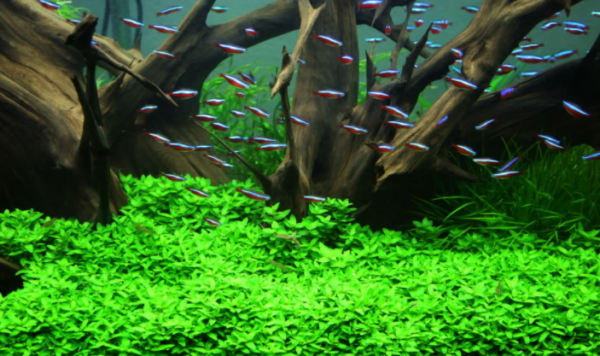
Staurogyne Repens Carpet Tank Size and Specifications
Optimum Tank Size for Staurogyne Repens Carpet
The recommended tank size for Staurogyne Repens Carpet is 10 gallons.
Staurogyne repens’ only drawback is that it needs very precise water conditions to grow, which is why it is only found in a few places of South America. As a result, you’ll need to make the Rio Cristalino as realistic as possible in your aquarium to offer the plant the best possible chance of thriving.
The Staurogyne plant requires a tank with a minimum capacity of 10 gallons to thrive. The plant is best utilized as a foreground specimen in small aquariums. Still, it may be used to great advantage in bigger tanks to form a carpet that stretches across the entire aquarium’s bottom.
Substrate
The plant requires a nutrient-rich substrate, combining tiny pebbles and aquarium soil or just aquarium soil. Remember that fine-grained aquarium materials assist Staurogyne repens’ small roots in penetrating easily and providing better anchoring. These substrates are high in nutrients and allow Staurogyne repens’ thin roots to penetrate easily.
Water Parameters for Staurogyne Repens Carpet
Water Temperature
The ideal water temperature for Staurogyne Repens Carpet is between 20 to 30 degrees Celsius (68 to 86 degrees Fahrenheit).
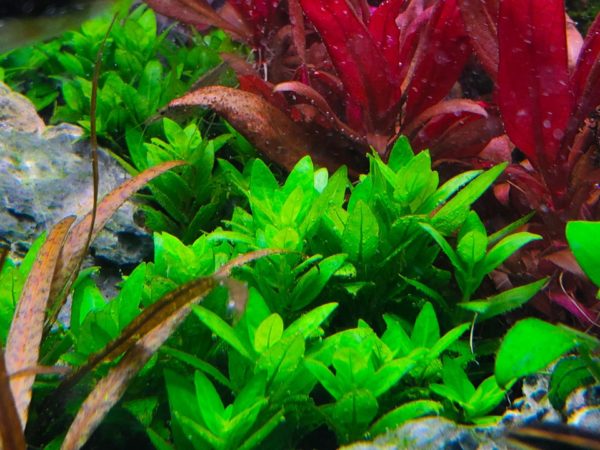
pH Level
The perfect water pH level for Staurogyne Repens Carpet is wide (from 5.0 to 8.0). pH levels between 6.0 and 7.0 are ideal.
Water Hardness
The plant prefers mild to moderately hard water, with optimal values ranging from 1 to 10 dGH.
Staurogyne Repens Carpet Tank Landscape
Lighting for Staurogyne Repens Carpet Tanks
To flourish in the aquarium, Staurogyne repens require intense illumination; hence medium to high lighting (30–50 PAR) should be provided. The plant begins to grow upwards in low-light situations as if it is striving to access the surface for more light.
Sustain a photoperiod of a maximum of 10 hours each day; leaving the lights on for prolonged periods will cause undesired algae to bloom in the aquarium. A full spectrum LED lighting fixture might be employed to provide the desired light intensity.
Nitrogen/other nutrient requirements for Staurogyne Repens Carpet tank?
Staurogyne repens is a robust and vital plant that thrives in medium to high light conditions with CO2 supplementation. Fertilization is also required for Staurogyne repens. To preserve the fresh green colors of the leaves and constant covering growth, a combination of a nutrient-rich substrate and a supply of micronutrients is required. If the vertical branches were clipped before planting, it could be months before they need to be trimmed again. New vertical shoots may well be trimmed every week at that time.
Staurogyne repens, in addition to being a great foreground flora for the planted tank, is also an ideal choice for nano aquaria due to its slow, creeping growth and hardiness.
Staurogyne Repens Care and Maintenance
When it comes to caring for this resilient plant, there isn’t much to do; its small size and moderate growth pattern make upkeep simple. You won’t have to clip the shoots as often because the plant doesn’t grow quickly. In any case, if the carpet becomes too high or you discover regions that are significantly higher than others, trim the carpet to keep it level, neat, and compact.
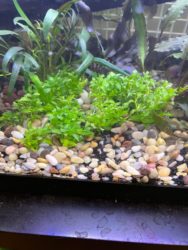
Although Staurogyne repens is commonly referred to as a carpet plant, it is not one. Staurogyne repens is a non-carpeting stem plant. By clipping and replanting the cuttings, we may achieve the carpet appearance. You may also use this time to snip rotting leaves and stems; the goal is to separate the browns from the greens in your aquarium to create a homogeneous and appealing carpet.
Also, make sure to replace the water regularly to keep it clean and clear. Clearwater in the tank will aid in the penetration of light to the plants on the lower levels, including your Staurogyne carpet.
Dose liquid supplements in the proper amounts into the tank water to guarantee that the plants get enough necessary nutrients. This will go a long way toward fostering healthy roots and shoot growth, so if you want to keep your carpet looking fresh, dense, and bright green, you should incorporate this method into your routine.
Propagation of the Staurogyne repens
Staurogyne repens plantation process is not difficult; nevertheless, to get the desired quantity and quality of the foreground vegetation in the aquarium, one must follow a precise planting guideline.
According to certain aquarists, we should plant one stem for every two gallons (8L) of water to avoid overcrowding. However, it is preferable to keep a distance of roughly 2 to 3 inches (5 to 7 cm) between each other at first. It will lessen competition early on and allow them to establish themselves. Into the substrate, bury every stem about 12 to 34 of an inch (1.5 to 2 cm) deep. When planted this way, the thin roots will easily penetrate the aquarium substrate. Tweezers can be used to insert separate plants into the substrate.
Check the growth after 3-4 weeks to see if any large gaps need to be closed. If so, add a few additional stems. To encourage horizontal development, use liquid fertilizers and maintain the shoots trimmed from time to time. If you do have floating plants in the tank, make sure the water surface is clean enough for light to reach the carpet. After a few months, if these events are effectively executed, the desired carpeting effect will be accomplished. In terms of propagation, Staurogyne repens can produce vegetative buds, which is more common in its emergent phase.
Side shoots arise from the parent plant; these sections detach and fall to the ground, where they grow and develop into separate plants. However, mature stems can be readily clipped and replanted in the aquarium in the substrate. You don’t have to remove the entire stem; simply cut a 2-inch (5 cm) piece and set it in the substrate. The plants will develop and grow into a new plant even if there are no visible roots; it’s that easy.
Staurogyne Repens Carpet Compatibility and Tank Mates
Staurogyne repens is fussy regarding tankmates due to its delicate and pleasant nature. The plant will thrive in tanks with creatures that won’t eat the plant’s soft leaves.
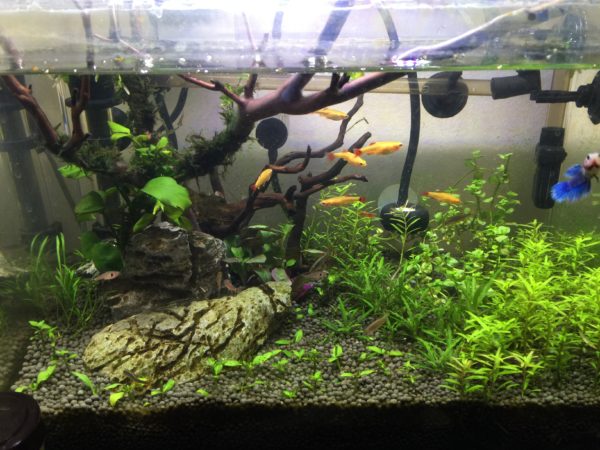
Ideal Staurogyne Repens Carpet Tank Mates
Staurogyne repens is fussy regarding tankmates due to its delicate and pleasant nature. The plant will thrive in tanks with creatures that won’t eat the plant’s soft leaves. The following tankmates are compatible:
Fish: Small, tranquil communal fish like:
- Bleeding Heart Tetras
- Swordtails
- White Mountain Minnows
- Neon Tetras, Mollies
- Killifish, Zebra Danio
- Sunburst Platy
- Pygmy Cory Catfish.
Shrimp: It is feasible to retain Staurogyne repens with any dwarf shrimp species because it can survive a wide range of pH.
Bad Tank Mates for Staurogyne Repens Carpet
Avoid species including:
- Koi fish
- Goldfish
- Oscars
- Clown loaches, Rainbow
- Jack Dempsey
- African Cichlids
They may find Staurogyne repens appealing. In planted tanks, these species can be somewhat problematic. Furthermore, Staurogyne repens do not mix well with most crayfish or even freshwater crabs. These animals will cut, eat, and uproot everything in the tank. So be on the lookout!
Small Buying Guide
This species is widely available at local fish markets; if you can’t get it there, look online since several internet dealers sell it. You should avoid getting sick or damaged plants because they won’t grow properly in the tank. Healthy stems are often fresh, upright, and green or slightly brown. For $5-$10, you can get a large bunch with up to 10 stems, which should be plenty to aquascape a 10 to 20-gallon fish tank.
If required, quarantine Staurogyne repens before introducing it to your tank. For instance, if these are “in vitro” plants, there is no necessity to do so because they are grown on nutritional media under sterile laboratory conditions. In all other situations:
The plant may be infected with parasites, pests such as snails, or even predators (damselfly nymphs, dragonflies, etc.). To get rid of parasites, snails, and other pests, it could be treated with chemicals (pesticide). Fish, shrimp, and other invertebrates, on the other hand, are exceedingly poisonous to these compounds.
Staurogyne repens, according to the study, is tough enough to withstand a high concentration of H2O2 (hydrogen peroxide). Furthermore, explants treated with 5.5 percent H2O2 for 20 minutes produced the highest effects.
Facts about Staurogyne Repens Carpet
- Staurogyne Repens Carpet is recognized for its slow growth rate, which averages around 1 inch each month and a half.
- Staurogyne Repens Carpet is a voracious root feeder that requires a rich, healthy, and fine substrate. It can take numerous nutrients from the water column.
- When determining where to grow Staurogyne repens, keep in mind that tall ornaments and thick, broad-leaved plants may block off the light that the plants require.
Are Staurogyne Repens Carpet Right For You?
It isn’t easy to think of why you shouldn’t add this plant to the aquarium. Its hardiness allows it to be kept in a range of water settings and with various freshwater fish.
It develops slowly, so you won’t have to trim it very often, and when you do, the cuttings can be used to start new plants. It’s really easy to spread. The most important thing to keep in mind is to keep Staurogyne repens away from any fish known to consume plants.
FAQs
Is Staurogyne repens contagious?
Yes, as the side branches fall off and self-produce, this plant will organically spread.
Is it possible to float a Staurogyne repens carpet?
Avoid planting Staurogyne repens behind tall decorations or thick, broad-leaved plants that may block the plants’ critical light. Similarly, if you have floating plants, they must be kept in their section of the tank.
In an aquarium, how do you cultivate Staurogyne repens carpet?
Staurogyne repens are good for the aquarium’s foreground and middle area. The tallest upright stems should be trimmed off before aquarium planting, and each pot should really be subdivided into 2 to 4 pieces, which should then be planted close together in a small group.
Is CO2 required for Staurogyne repens?
Staurogyne repens is a robust and vital plant that thrives in medium to high light conditions with CO2 supplementation. Fertilization is also required for Staurogyne repens.
Conclusion
Staurogyne repens is an excellent choice for almost any freshwater tank. It looks wonderful, is simple to maintain, and will make a major difference in the overall health of your tank. This plant grows slowly, thrives with or even without CO2, and takes up to 2-3 months to thickly cover the foreground of the tank after planting, obviating the necessity for frequent shoot cutting.
There are several things to keep in mind when assessing Staurogyne Repens samples for your aquarium. Knowing which plants are beneficial to your fish tank and which ones to avoid will help you avoid accidentally introducing bacteria or parasites. Putting forth the effort today will aid in the creation of a lush and long-lasting Staurogyne Repens carpet in the future.
The leaves of Staurogyne Repens are bright green. When planted in low-light environments, their leaves have a neon-like aspect and appear glowing. Search for Staurogyne Repens specimens with uniformly colored leaves; the foliage of your chosen Staurogyne plants should be free of discolorations, brown patches, or pale areas. The smoothness and robustness of a plant’s stems are another good sign of its health. The strong stems of Staurogyne Repens are responsible for supporting the plant’s dense foliage. By gently tugging on the chosen plants’ stems, which should not show evidence of breaking or ripping, select Staurogyne specimens with clean and firm stems.
Multiple thin, white strands make up the Staurogyne Repens plant’s roots. Staurogyne Repens is indeed a substrate feeder or root feeder; hence these roots are critical to the plant’s health. Examine the roots of the mud mats you’ve chosen, which ought to be free of pests and gunk and resistant to breakage and tearing.
Based on their age and size, Staurogyne Repens is commonly sold in bunches for $5-$10. Choose the best Staurogyne Repens species you can locate and buy only enough to cover around half of your aquarium’s substrate. You may always come back and buy more Staurogyne Repens once you have learned more regarding the plant and have gained expertise with it as an aquascaping component in your fish tank.
